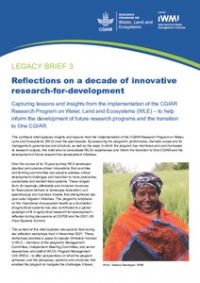This blog is part of WLE’s participation in the conference on “Water in the Anthropocene: Challenges for Science and Governance. Indicators, Thresholds and Uncertainties of the Global Water System“. A series of blogs have been written; click here for more information.
The Indus rises on the Tibetan plateau in the Himalayas and runs down through Pakistan to the Arabian Sea. Along its way it feeds the largest connected irrigation system in the world, covering more than 18 million hectares of farmland. It also powers four major hydropower facilities, upstream of the farming areas.
While other countries often have mixed priorities for their water, Pakistan has always been clear. The Indus is for irrigation. Hydropower is a secondary concern. And yet, Pakistan could also use more energy, because almost one in four households (24%) has electricity for less than six hours a day and the lack of reliable energy has prompted industries to move away or sink capital into private generating capacity. There are several spots where more hydropower could be developed, but how would that affect agricultural production?
Not much, according to a model developed by Claudia Ringler, joint leader of the River Basins research theme of the CGIAR Research Program on Water Land and Ecosystems (WLE), and her colleagues. At least, not unless Pakistan’s water allocation rules change. Ringler shared the model at the recent [Water in the Anthropocene] conference in Bonn (see Ringler's presentation).
In essence the model looks at the economic value of hydropower and agriculture over the whole basin, taking into account how different crops perform with different amounts of water. Tested against historical data, the model performs reasonably well, so Ringler felt confident projecting into the future under different scenarios, maximising either agricultural productivity or hydropower generation, with either the current water storage regime or with two additional storage dams that Pakistan has long been thinking about inserted into the model.
There are indeed trade-offs between energy and food: maximising hydropower generation increases profits in the sector by $100 million from US$2.9 billion to US$3.0 billion, with a roughly equal decrease in agricultural profits. Without additional water storage, agricultural profits barely change when the model maximises agricultural productivity. This result reflects the existing allocation rules, which favour farming.
Bring the additional storage dams into the equations, however, and the picture changes completely. Now, maximising hydropower decreases agricultural production by almost two-thirds, while energy production goes up by about one tenth. However, if the current rules for allocating water, which favour agriculture, remain, then maximising agriculture in the model increases hydropower by 72% while barely affecting agricultural output. The water released for agriculture passes through the turbines, generating additional energy even though the reason it is being released is for irrigation.
Construction of the proposed dams has been stalled for years, largely by political considerations, but the policy implications of the model are clear: Pakistan could get considerably more hydropower from the system without affecting crop yields if it continues to prioritise irrigation.
In some respects there need not be any trade-off between hydropower and irrigation. Water can be released from dams when farmers need it, and can generate electricity on its way. Hydropower is a non-consumptive use of water, in that after it has generated power the water is still available for other uses, like irrigation. In reality, though, there are conflicts, largely over the timing of water release. If the peak season for energy needs does not coincide with the need for irrigation water, that could pose difficulties. For example, if energy is needed in winter, when crops are not growing, then that water might not be available in summer, when agriculture needs it.
“There are always trade-offs for water and other resources among competing users, even if these are not necessarily evident,” Ringler says. An analysis that correctly accounts for these trade-offs can help provide useful insights for hydropower and irrigation alike. And once trade-offs have been quantified, it is important to develop alternative investment and policy options to reduce the trade-offs.
“In Pakistan,” Ringler says, “the key benefit of the additional storage is that you reduce the impact of variability in the water flow.” Variability, of course, is predicted to increase under climate change. The model currently ignores the effects of climate change, and plugging that gap is a high priority for future work.




/index.jpg?itok=EzuBHOXY&c=feafd7f5ab7d60c363652d23929d0aee)
















Comments
Thank you for the Water powered trade-offs in the Indus River Basin information. You efforts putting this blog together was worth the while. I like this one Jeremy.